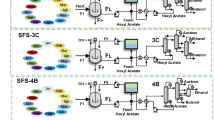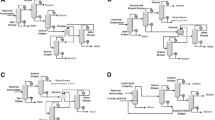Abstract
Ethanol production from non-edible feedstock has received significant attention over the past two decades. The utilisation of agricultural residues within the biorefinery concept can positively contribute to the renewable production of fuels. To this end, this study proposes the utilisation of bagasse in a hybrid conversion route for ethanol production. The main steps of the process are the gasification of the raw material followed by syngas fermentation to ethanol. Aspen plus was utilised to rigorously design the biorefinery coupled with Matlab to perform process optimisation. Based on the simulations, ethanol can be produced at a rate of 283 L per dry tonne of bagasse, achieving energy efficiency of 43% and according to the environmental analysis, is associated with low CO2 emissions. The conduction of a typical discounted cash flow analysis resulted in a minimum ethanol selling price of 0.69 $ L−1. The study concludes with multiobjective optimisation setting as objective functions the conflictive concepts of total investment costs and exergy efficiency. The total cost rate of the system is minimised whereas the exergy efficiency is maximised by using a genetic algorithm. This way, various process configurations and trade-offs between the investigated criteria were analysed for the proposed biorefinery system.








Similar content being viewed by others
References
He, J., Zhang, W.: Techno-economic evaluation of thermo-chemical biomass-to-ethanol. Appl. Energy 88(4), 1224–1232 (2011). https://doi.org/10.1016/j.apenergy.2010.10.022
Naik, S.N., Goud, V.V., Rout, P.K., Dalai, A.K.: Production of first and second generation biofuels: a comprehensive review. Renew. Sustain. Energy Rev. 14(2), 578–597 (2010). https://doi.org/10.1016/j.rser.2009.10.003
Antizar-Ladislao, B., Turrion-Gomez, J.L.: Second-generation biofuels and local bioenergy systems. Biofuels, Bioprod. Biorefin. 2(5), 455–469 (2008). https://doi.org/10.1002/bbb.97
Mohr, A., Raman, S.: Lessons from first generation biofuels and implications for the sustainability appraisal of second generation biofuels. Energy Policy 63, 114–122 (2013). https://doi.org/10.1016/j.enpol.2013.08.033
Gupta, A., Verma, J.P.: Sustainable bio-ethanol production from agro-residues: a review. Renew. Sustain. Energy Rev. 41, 550–567 (2015). https://doi.org/10.1016/j.rser.2014.08.032
Saini, J.K., Saini, R., Tewari, L.: Lignocellulosic agriculture wastes as biomass feedstocks for second-generation bioethanol production: concepts and recent developments. 3 Biotech 5(4), 337–353 (2015). https://doi.org/10.1007/s13205-014-0246-5
Srivastava, N., Rawat, R., Singh Oberoi, H., Ramteke, P.W.: A review on fuel ethanol production from lignocellulosic biomass. Int. J. Green Energy 12(9), 949–960 (2015). https://doi.org/10.1080/15435075.2014.890104
Liguori, R., Ventorino, V., Pepe, O., Faraco, V.: Bioreactors for lignocellulose conversion into fermentable sugars for production of high added value products. Appl. Microbiol. Biotechnol. 100, 597–611 (2016). https://doi.org/10.1007/s00253-015-7125-9
Fang, K., Li, D., Lin, M., Xiang, M., Wei, W., Sun, Y.: A short review of heterogeneous catalytic process for mixed alcohols synthesis via syngas. Catal. Today 147(2), 133–138 (2009). https://doi.org/10.1016/j.cattod.2009.01.038
Acharya, B., Roy, P., Dutta, A.: Review of syngas fermentation processes for bioethanol. Biofuels 5(5), 551–564 (2014). https://doi.org/10.1080/17597269.2014.1002996
Bertsch, J., Müller, V.: Bioenergetic constraints for conversion of syngas to biofuels in acetogenic bacteria. Biotechnol. Biofuels 8(1), 210 (2015). https://doi.org/10.1186/s13068-015-0393-x
Piccolo, C., Bezzo, F.: A techno-economic comparison between two technologies for bioethanol production from lignocellulose. Biomass Bioenergy 33(3), 478–491 (2009). https://doi.org/10.1016/j.biombioe.2008.08.008
Wagner, H., Kaltschmitt, M.: Biochemical and thermochemical conversion of wood to ethanol—simulation and analysis of different processes. Biomass Convers. Biorefin. 3(2), 87–102 (2013). https://doi.org/10.1007/s13399-012-0064-0
Roy, P., Dutta, A., Deen, B.: Greenhouse gas emissions and production cost of ethanol produced from biosyngas fermentation process. Bioresour. Technol. 192, 185–191 (2015). https://doi.org/10.1016/j.biortech.2015.05.056
Pandey, A., Soccol, C.R., Nigam, P., Soccol, V.T., Vandenberghe, L.P.S., Mohan, R.: Biotechnological potential of agro-industrial residues. II: cassava bagasse. Bioresour. Technol. 74(1), 81–87 (2000). https://doi.org/10.1016/S0960-8524(99)00143-1
Zanin, G.M., Santana, C.C., Bon, E.P., Giordano, R.C., de Moraes, F.F., Andrietta, S.R., de Carvalho Neto, C.C., Macedo, I.C., Fo, D.L., Ramos, L.P., Fontana, J.D.: Brazilian bioethanol program. Appl. Biochem. Biotechnol. 84–86, 1147–1161 (2000)
Zabed, H., Sahu, J.N., Boyce, A.N., Faruq, G.: Fuel ethanol production from lignocellulosic biomass: an overview on feedstocks and technological approaches. Renew. Sustain. Energy Rev. 66, 751–774 (2016). https://doi.org/10.1016/j.rser.2016.08.038
Balat, M., Balat, H.: Recent trends in global production and utilization of bio-ethanol fuel. Appl. Energy 86(11), 2273–2282 (2009). https://doi.org/10.1016/j.apenergy.2009.03.015
Ververis, C., Georghiou, K., Danielidis, D., Hatzinikolaou, D.G., Santas, P., Santas, R., Corleti, V.: Cellulose, hemicelluloses, lignin and ash content of some organic materials and their suitability for use as paper pulp supplements. Bioresour. Technol. 98(2), 296–301 (2007). https://doi.org/10.1016/j.biortech.2006.01.007
Gao, Y., Xu, J., Zhang, Y., Yu, Q., Yuan, Z., Liu, Y.: Effects of different pretreatment methods on chemical composition of sugarcane bagasse and enzymatic hydrolysis. Bioresour. Technol. 144, 396–400 (2013). https://doi.org/10.1016/j.biortech.2013.06.036
Bhatia, L., Johri, S., Ahmad, R.: An economic and ecological perspective of ethanol production from renewable agro waste: a review. AMB Express 2(1), 65 (2012). https://doi.org/10.1186/2191-0855-2-65
Isikgor, F.H., Becer, C.R.: Lignocellulosic biomass: a sustainable platform for the production of bio-based chemicals and polymers. Polym. Chem. 6(25), 4497–4559 (2015). https://doi.org/10.1039/C5PY00263J
Mosier, N., Wyman, C., Dale, B., Elander, R., Lee, Y.Y., Holtzapple, M., Ladisch, M.: Features of promising technologies for pretreatment of lignocellulosic biomass. Bioresour. Technol. 96(6), 673–686 (2005). https://doi.org/10.1016/j.biortech.2004.06.025
Gassner, M., Maréchal, F.: Thermo-economic process model for thermochemical production of synthetic natural gas (SNG) from lignocellulosic biomass. Biomass Bioenergy 33(11), 1587–1604 (2009). https://doi.org/10.1016/j.biombioe.2009.08.004
Michailos, S., Parker, D., Webb, C.: Comparative analysis of synthetic natural gas versus hydrogen production from bagasse. Chem. Eng. Technol. 40(3), 546–554 (2017). https://doi.org/10.1002/ceat.201600424
Farzad, S., Mandegari, M.A., Görgens, J.F.: A critical review on biomass gasification, co-gasification, and their environmental assessments. Biofuel Res. J. 3(4), 483–495 (2016). https://doi.org/10.18331/brj2016.3.4.3
Fu, Q., kansha, Y., Song, C., Liu, Y., Ishizuka, M., Tsutsumi, A.: An advanced cryogenic air separation process based on self-heat recuperation for CO2 separation. Energy Procedia 61, 1673–1676 (2014). https://doi.org/10.1016/j.egypro.2014.12.189
Perrin, N., Dubettier, R., Lockwood, F., Tranier, J.-P., Bourhy-Weber, C., Terrien, P.: Oxycombustion for coal power plants: advantages, solutions and projects. Appl. Therm. Eng. 74, 75–82 (2015). https://doi.org/10.1016/j.applthermaleng.2014.03.074
Trippe, F., Fröhling, M., Schultmann, F., Stahl, R., Henrich, E.: Techno-economic assessment of gasification as a process step within biomass-to-liquid (BtL) fuel and chemicals production. Fuel Process. Technol. 92(11), 2169–2184 (2011). https://doi.org/10.1016/j.fuproc.2011.06.026
Sudiro, M., Bertucco, A.: Production of synthetic gasoline and diesel fuel by alternative processes using natural gas and coal: process simulation and optimization. Energy 34(12), 2206–2214 (2009). https://doi.org/10.1016/j.energy.2008.12.009
Panopoulos, K.D., Fryda, L.E., Karl, J., Poulou, S., Kakaras, E.: High temperature solid oxide fuel cell integrated with novel allothermal biomass gasification: part I: modelling and feasibility study. J. Power Sources 159(1), 570–585 (2006). https://doi.org/10.1016/j.jpowsour.2005.12.024
Erlich, C., Fransson, T.H.: Downdraft gasification of pellets made of wood, palm-oil residues respective bagasse: experimental study. Appl. Energy 88(3), 899–908 (2011). https://doi.org/10.1016/j.apenergy.2010.08.028
Sreejith, C.C., Muraleedharan, C., Arun, P.: Thermo-chemical analysis of biomass gasification by gibbs free energy minimization model-part: II (optimization of biomass feed and steam to biomass ratio). Int. J. Green Energy 10(6), 610–639 (2013). https://doi.org/10.1080/15435075.2012.709203
Drzyzga, O., Revelles, O., Durante-Rodríguez, G., Díaz, E., García, J.L., Prieto, A.: New challenges for syngas fermentation: towards production of biopolymers. J. Chem. Technol. Biotechnol. 90(10), 1735–1751 (2015). https://doi.org/10.1002/jctb.4721
Arora, D., Basu, R., Breshears, F.S., Gaines, L.D., Hays, K.S., Phillips, J.R., Wikstrom, C.V., Clausen, E.C.: J. L. Gaddy. United States. Department of Energy. Office of Energy Efficiency and Renewable Energy., United States. Department of Energy. Albuquerque Operations Office., United States. Department of Energy. Office of Scientific and Technical Information.: Production of ethanol from refinery waste gases. Final report, April 1994–July 1997. United States. Dept. of Energy. Office of Energy Efficiency and Renewable Energy; distributed by the Office of Scientific and Technical Information, U.S. Dept. of Energy,. http://www.osti.gov/servlets/purl/565441-UPx17r/webviewable/ (1997)
De Kam, M.J., Vance Morey, R., Tiffany, D.G.: Biomass integrated gasification combined cycle for heat and power at ethanol plants. Energy Convers. Manag. 50(7), 1682–1690 (2009). https://doi.org/10.1016/j.enconman.2009.03.031
Williams, T.C., Shaddix*, C.R., Schefer, R.W.: Effect of syngas composition and CO2-diluted oxygen on performance of a premixed swirl-stabilized combustor. Combust. Sci. Technol. 180(1), 64–88 (2007). https://doi.org/10.1080/00102200701487061
Tassios, D.P.: Extractive and azeotropic distillation, In: Advances in chemistry, vol. 115. American Chemical Society, Washington, (1974)
Park, S.R., Pandey, A.K., Tyagi, V.V., Tyagi, S.K.: Energy and exergy analysis of typical renewable energy systems. Renew. Sustain. Energy Rev. 30, 105–123 (2014). https://doi.org/10.1016/j.rser.2013.09.011
Michailos, S., Parker, D., Webb, C.: A multicriteria comparison of utilizing sugar cane bagasse for methanol to gasoline and butanol production. Biomass Bioenerg. 95, 436–448 (2016). https://doi.org/10.1016/j.biombioe.2016.06.019
Bridgwater, A.V.: Step counting methods for preliminary capital cost estimating. Cost Eng. 23(5), 293–302 (1981)
Lucia, A., Towler, G.: Chemical engineering design principles, practice, and economics of plant and process design by. and R. Sinnott. AIChE J. 54(11), 3034–3035 (2008). https://doi.org/10.1002/aic.11633
Sadhukhan, J., Ng, K.S., Hernandez, E.M.: Economic analysis. Biorefineries and chemical processes. pp. 43–61. Wiley, Hoboken (2014)
Hamelinck, C.N., Hooijdonk, G.v., Faaij, A.P.C.: Ethanol from lignocellulosic biomass: techno-economic performance in short-, middle- and long-term. Biomass Bioenergy 28(4), 384–410 (2005). https://doi.org/10.1016/j.biombioe.2004.09.002
Caputo, A.C., Palumbo, M., Pelagagge, P.M., Scacchia, F.: Economics of biomass energy utilization in combustion and gasification plants: effects of logistic variables. Biomass Bioenergy 28(1), 35–51 (2005). https://doi.org/10.1016/j.biombioe.2004.04.009
Peters, M., Timmerhaus, K., West, R.: Plant design and economics for chemical engineers. McGraw-Hill Education, New York (2003)
Gubicza, K., Nieves, I.U., Sagues, W.J., Barta, Z., Shanmugam, K.T., Ingram, L.O.: Techno-economic analysis of ethanol production from sugarcane bagasse using a liquefaction plus Simultaneous Saccharification and co-Fermentation process. Bioresour. Technol. 208, 42–48 (2016). https://doi.org/10.1016/j.biortech.2016.01.093
UNICA – Brazilian Sugarcane Industry Association. Report. http://www.unicadata.com.br (Accessed 4/02/2015)
Humbird, D., National Renewable Energy Laboratory (U.S.), Harris Group Inc.: Process design and economics for biochemical conversion of lignocellulosic biomass to ethanol : dilute-acid pretreatment and enzymatic hydrolysis of corn stover. Natl. Renew. Energy Lab. http://purl.fdlp.gov/GPO/gpo8034
Jones, S., Meyer, P., Snowden-Swan, L., Padmaperum, A., Tan, E., Dutta, A., Jacobson, J., Cafferty, K.: Pacific Northwest National Laboratory (U.S.)., United States. Department of Energy., United States. Department of Energy. Office of Scientific and Technical Information.: Process design and economics for the conversion of lignocellulosic biomass to hydrocarbon fuels fast pyrolysis and hydrotreating bio-oil pathway. United States. Department of Energy. ; distributed by the Office of Scientific and Technical Information, U.S. Department of Energy,. http://www.osti.gov/servlets/purl/1115839/ (2013)
de Jong, S., Hoefnagels, R., Faaij, A., Slade, R., Mawhood, R., Junginger, M.: The feasibility of short-term production strategies for renewable jet fuels—a comprehensive techno-economic comparison. Biofuels, Bioprod. Biorefin. 9(6), 778–800 (2015). https://doi.org/10.1002/bbb.1613
Rubin, E.S., Azevedo, I.M.L., Jaramillo, P., Yeh, S.: A review of learning rates for electricity supply technologies. Energy Policy 86(Supplement C), 198–218 (2015). https://doi.org/10.1016/j.enpol.2015.06.011
Albarelli, J.Q., Onorati, S., Caliandro, P., Peduzzi, E., Meireles, M.A.A., Marechal, F., Ensinas, A.V.: Multi-objective optimization of a sugarcane biorefinery for integrated ethanol and methanol production. Energy (2015). https://doi.org/10.1016/j.energy.2015.06.104
Geraili, A., Sharma, P., Romagnoli, J.A.: A modeling framework for design of nonlinear renewable energy systems through integrated simulation modeling and metaheuristic optimization: applications to biorefineries. Comput. Chem. Eng. 61, 102–117 (2014). https://doi.org/10.1016/j.compchemeng.2013.10.005
Devarapalli, M., Atiyeh, H.K.: A review of conversion processes for bioethanol production with a focus on syngas fermentation. Biofuel Res. J. 2(3), 268–280 (2015). https://doi.org/10.18331/brj2015.2.3.5
Richter, H., Martin, M., Angenent, L.: A two-stage continuous fermentation system for conversion of syngas into ethanol. Energies 6(8), 3987 (2013)
Author information
Authors and Affiliations
Corresponding author
Rights and permissions
About this article
Cite this article
Michailos, S., Parker, D. & Webb, C. Design, Sustainability Analysis and Multiobjective Optimisation of Ethanol Production via Syngas Fermentation. Waste Biomass Valor 10, 865–876 (2019). https://doi.org/10.1007/s12649-017-0151-3
Received:
Accepted:
Published:
Issue Date:
DOI: https://doi.org/10.1007/s12649-017-0151-3




